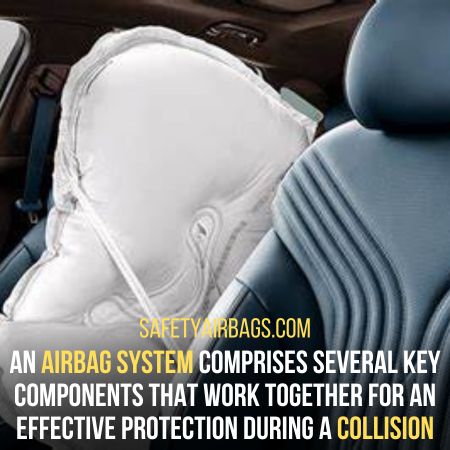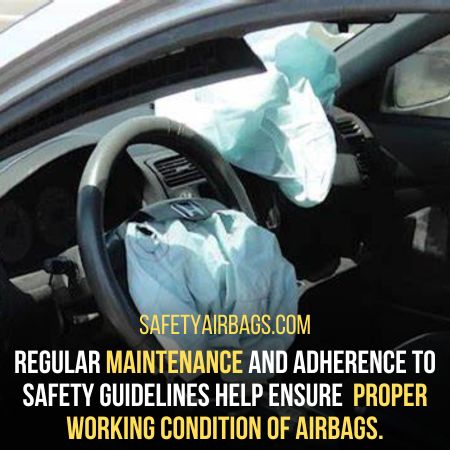How hard is it to set off an airbag? Intentionally setting off an airbag outside a genuine emergency is dangerous, illegal, and strongly discouraged.
What Will I learn
- 1 How Hard Is It To Set Off An Airbag
- 2 Why Is Setting Off An Airbag Harmful – Risks And Dangers of Improper Airbag Deployment
- 3 Understanding How Airbags Work: Enhancing Vehicle Safety
- 4 Legal And Ethical Implications
- 5 Importance Of Safety And Proper Maintenance
- 6 Conclusion:
This article will highlight why setting off an airbag is harmful. It will also discuss how an airbag deploys in cases of accidents.
How Hard Is It To Set Off An Airbag
Deploying an airbag outside of an emergency can be extremely dangerous and illegal in most jurisdictions.
Airbags are designed to deploy during specific circumstances, such as a severe impact during a car crash.
The deployment of an airbag is triggered by sensors that detect rapid deceleration, sudden changes in vehicle direction, etc.

These sensors send signals to the airbag control module, activating the system.
Deliberately attempting to set off an airbag outside of an emergency is unsafe and illegal.
It can cause serious injury or even death due to the forceful deployment of the airbag, designed to protect vehicle occupants during an accident.
Why Is Setting Off An Airbag Harmful – Risks And Dangers of Improper Airbag Deployment
Improper airbag deployment poses significant risks and dangers that can result in severe injuries or even fatalities.
While airbags are designed to enhance occupant safety during crashes, their deployment outside of real emergencies can have detrimental consequences.
Here are some key risks and dangers associated with improper airbag deployment:
1. Impact Force:
Airbags are designed to inflate and cushion occupants during a car crash rapidly.
When an airbag deploys, it does so with a significant amount of force to counteract the forward momentum of the occupants.
Suppose an airbag is set off in a non-emergency situation. In that case, this force can cause serious injuries, such as fractures, concussions, or internal injuries.
This happens because the occupants are not prepared or positioned correctly for impact.
2. Lack Of Restraints:
During a legitimate airbag deployment in a crash, occupants typically wear seat belts, which work in conjunction with the airbag to provide optimal protection.
When an airbag is set off intentionally, the occupants may not be wearing seat belts.
This increases the risk of being thrown forward or out of the vehicle, leading to severe injuries.
3. Uncontrolled Environment:
In a controlled crash scenario, airbags are designed to deploy in a specific manner to protect occupants.
When an airbag is set off outside these controlled conditions, the environment may be unpredictable and hazardous.
Objects or obstacles within the vehicle can cause additional injuries, and the deployment itself can disorient or startle the occupants, leading to potentially dangerous situations.
4. Legal Consequences:
Deliberately tampering with airbag systems or attempting to set off an airbag outside of an emergency is illegal in most jurisdictions.
Such activities can result in legal repercussions, including fines and criminal charges.
Understanding How Airbags Work: Enhancing Vehicle Safety
Airbags have become a vital component of modern vehicle safety systems, significantly reducing the risk of severe injuries during crashes.

An airbag system comprises several key components that work together seamlessly to provide effective protection during a collision:
1. Airbag Module:
The airbag module consists of the airbag itself, typically housed in the driver’s steering wheel and the dashboard for the front passenger.
It also includes the inflator, which contains a chemical propellant responsible for rapidly inflating the airbag upon deployment.
2. Crash Sensors:
Crucial to the system’s functionality, crash sensors detect the deceleration, changes in vehicle direction, and impact severity during a crash.
These sensors send signals to the airbag control module, triggering deployments.
3. Airbag Control Module:
Acting as the brain of the airbag system, the control module receives signals from the crash sensors and determines whether airbag deployment is necessary.
It precisely analyzes the data to ensure timely and appropriate deployment.
Deployment Process During A Crash Scenario:
When a vehicle experiences a crash scenario, the deployment process of an airbag occurs in a matter of milliseconds, providing crucial protection to the vehicle occupants.
1. Sensor Activation:
Airbags rely on various sensors to detect the conditions that warrant their deployment during a crash.
These sensors ensure airbags activate when necessary, providing optimal protection to vehicle occupants.
The crash sensors detect abrupt deceleration or impact forces. It then relays this information to the airbag control module.
2. Signal Transmission:
Once the control module receives the signals indicating a crash, it evaluates the severity and nature of the impact.
If the conditions meet the predetermined deployment criteria.
3. Airbag Ignition and Inflation:
The deployment process commences with the ignition of the inflator unit.
The chemical propellant inside the inflator ignites, generating a controlled explosion.
This explosion produces a large volume of gas (typically nitrogen) that rapidly inflates the airbag cushion.
4. Cushioning And Protection:
As the airbag inflates, it expands toward the vehicle occupants.
The rapidly expanding cushion absorbs the impact forces, reducing the risk of severe head and upper body injuries by providing a soft, protective barrier.
Airbags And Other Safety Features Like Seat Belts:
Airbags and seat belts are complementary safety features that, when used together, offer the highest level of protection to vehicle occupants.
1. Seat Belt Role:
Seat belts secure occupants to their seats, preventing them from being forcefully thrown forward during a crash.

They restrain the body, ensuring the airbags can deploy correctly and provide optimal protection.
2. Airbag And Seat Belt Synergy:
In the event of a crash, the coordinated deployment of airbags and the use of seat belts work together synergistically.
Seat belts hold occupants in the desired position, allowing the airbags to cushion and prevent severe injuries caused by impact forces.
Legal And Ethical Implications
Legal and ethical implications surround airbag systems’ use, tampering, and misuse.
Here are some key points regarding the legal and ethical considerations associated with airbags:
1. Legal Regulations:
Most jurisdictions have specific laws and regulations governing the use and deployment of airbags.
These laws typically mandate that airbags be used only for their intended purpose during genuine emergencies.
Intentionally tampering with or setting off an airbag outside of a legitimate emergency is illegal and can result in legal consequences, such as fines, penalties, or criminal charges.
2. Manufacturer Guidelines:
Vehicle manufacturers provide guidelines and instructions regarding airbag systems’ proper use, maintenance, and handling.
These guidelines should be followed to ensure the safe and effective operation of the airbags.
Failure to comply with manufacturer recommendations may have legal implications and impact insurance coverage or warranty claims.
3. Occupant Safety:
The primary purpose of airbags is to enhance occupant safety during crashes.
Engaging in activities that intentionally deploy airbags without a genuine emergency disregards the intended purpose and compromises the safety of vehicle occupants.
Ethically, prioritizing the well-being of oneself and others necessitates responsible use of safety devices and adherence to the intended functionality of airbags.
4. Professional Responsibility:
Automotive professionals, including mechanics and technicians, are responsible for upholding ethical standards in their work.
They should not engage in activities that tamper with or improperly deploy airbags.
They must follow industry best practices, adhere to safety guidelines, and provide accurate information and guidance to customers regarding airbag systems.
5. Public Safety Awareness:
Public awareness about the risks and dangers associated with improper airbag deployment is crucial.
Educating the general public about the legal and ethical implications can help prevent misuse and ensure the responsible use of airbags.
Importance Of Safety And Proper Maintenance
Safety and proper airbag system maintenance are paramount in ensuring their effectiveness and reliability.
Here are some key reasons why safety and proper maintenance should be prioritized:
1. Occupant Protection:
The primary purpose of airbags is to protect vehicle occupants during crashes by mitigating the risk of severe injuries.

Regular maintenance and adherence to safety guidelines help ensure that airbags are in proper working condition.
This includes maintaining the integrity of the sensors, control module, and inflator unit and ensuring that the airbag is free from damage or defects.
By prioritizing safety and maintenance, the chances of airbags deploying as intended during emergencies are significantly increased, enhancing occupant protection.
2. System Reliability:
Regular maintenance and safety checks contribute to the overall reliability of the airbag system.
Following manufacturer recommendations for inspections and servicing can identify and address potential issues promptly.
This helps prevent malfunctions or failures that could compromise the proper deployment of airbags.
A well-maintained airbag system instills confidence in its reliability and provides peace of mind to vehicle occupants.
3. Compliance with Regulations:
Adhering to safety and maintenance guidelines for airbags ensures compliance with legal regulations.
Many jurisdictions have specific requirements regarding the maintenance and functioning of airbag systems.
Failure to comply with these regulations may result in legal consequences, including fines or penalties.
Vehicle owners can meet their legal obligations and help create safer road environments by staying updated with maintenance schedules and safety guidelines.
4. Longevity and Cost-Effectiveness:
Proper maintenance extends the lifespan of airbag systems and reduces the likelihood of premature replacement.
Regular inspections and servicing can identify and address minor issues before they escalate into more significant problems.
Maintaining the airbag system’s integrity can minimize unnecessary costs associated with repairs or replacements.
Additionally, a well-maintained airbag system contributes to the vehicle’s overall value and resale potential.
Conclusion:
From a legal and ethical standpoint, tampering with airbag systems or intentionally deploying them inappropriately is illegal in most jurisdictions.
It is crucial to adhere to legal regulations and manufacturer guidelines to ensure airbags’ safe and intended use.
Proper maintenance and regular inspections of airbag systems contribute to their reliability and effectiveness, enhancing occupant protection.
